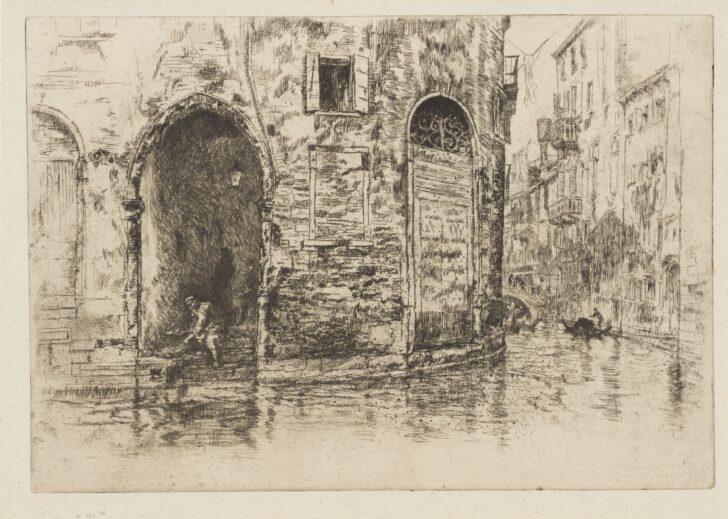Two Doorways, One of the ‘Twelve Etchings,’ or the ‘First Venice Set’
James Abbott McNeill Whistler

Description
Two Doorways, from the Twelve Etchings,
or the First Venice Set
1879–80
Etching and drypoint
Third state of six (Kennedy 193)
Bequest of Margaret Watson Parker, 1954/1.380
Two Doorways, from the Twelve Etchings,
or the First Venice Set
1879–80
Etching and drypoint
Fifth state of six (Kennedy 193)
Bequest of Margaret Watson Parker, 1954/1.381
This pair of impressions of Two Doorways from the First Venice Set allows the viewer to compare different states of the same plate. The earlier impression, a third state out of six, is printed in black ink, while the later one, a fifth state impression, is printed in dark brown ink. The third-state impression is on paper that is untrimmed and not signed in pencil with the butterfly signature, perhaps indicating that Whistler did not consider it sufficiently complete to merit signature and trimming; the artist often took trial proofs as he worked on a plate, making notes on the reverse side. The fifth-state impression, however, has had the margins trimmed to the edge of the plate mark and is signed on the tab that Whistler often left for his butterfly. On the reverse the artist noted, “Before last State.”
As the title indicates, two arched doorways—one closed, the other open—are the focus of the composition, providing a glimpse of two figures behind the man on the steps of the water-door. Much of the difference between the two states is concentrated on the dark doorway at the left. In the third-state impression, the viewer is able to look more deeply into the space behind the arched opening. As Whistler developed the image, the space behind the figure became darker and more mysterious; although the child immediately behind the central figure becomes more prominent, the second figure recedes into the gloom, while the pervading darkness throws into relief the glowing presence of the lantern.
Subject Matter:
As Otto Bacher recorded, Whistler often sought sites along the back canals that were full of possibilities, often working from the surface of the water in a gondola. Here the qualities of the old gothic and renaissance doors and crumbling walls attract the artist's attentions. In other states Whistler concentrated on the figures in the open doorway, redrawing them in relationship to the dark passage beyond.
Physical Description:
Seen from the water's edge, a canal in the foreground curves to the right and back into space. In the distant view, buildings with balconies and chimney pots are visible as well as a bridge that is cropped by the curve of the waterway. In the foreground, across the canal, are several arched entryways. A dark waterdoor is open and shows a man on the steps and two shadowy figures behind him framed in the doorway; a lantern hangs overhead. To the right, another arched doorway with a metal grille above faces the canal, but is closed. A small open window on the seond floor can be seen between the arched doors.
Usage Rights:
If you are interested in using an image for a publication, please visit https://umma.umich.edu/request-image/ for more information and to fill out the online Image Rights and Reproductions Request Form.